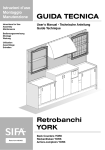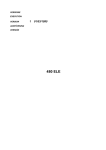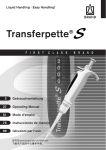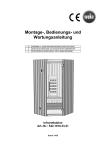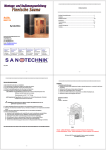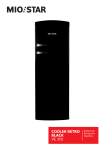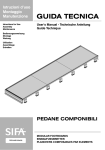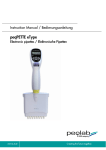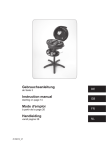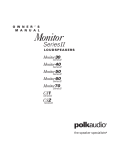Download Retro alzate spring
Transcript
Istruzioni d’uso Montaggio Manutenzione Istructions for Use Assembly Maintenance GUIDA TECNICA User’s Manual - Technische Anleitung Guide Technique Bedienungsanweisung Montage Wartung Utilisation Assemblage Entretien Retrobanchi SPRING Società Industria Frigoriferi e Arredamenti 61022 Colbordolo, 15/19 Tel. 0721.4741 - Fax 0721.497507 E-mail: [email protected] Sito Internet: http:// www.sifaspa.it RetroSpring120106 Back Counters SPRING Rückentheken SPRING Arrière-comptoirs SPRING ISTRUZIONI DI MONTAGGIO RETROBANCHI SPRING ASSEMBLY ISTRUCTIONS FOR SPRING BACK COUNTERS MONTAGEANWEISUNGEN RÜCKENTHEKEN SPRING INSTRUCTIONS DE MONTAGE ARRIERE-COMPTOIRS SPRING Pag.1 Assemblaggio Rtb e Rmc (istruzioni preliminari) Assembling Back counter unit and Coffee machine back counter unit (preliminary instructions) Zusammenbau Rückentheken und Kaffeemaschine-Rückenelement (Voranleitungen) Assemblage arrière-comptoirs et arrière-comptoirs Machine à café (instructions préliminaires) Fig.1 I moduli della linea “SPRING” vengono trasportati e movimentati su un fianco. Prima di procedere all'installazione inserire il piedino in plastica centrale sotto la base e rimuovere le strisce di scorrimento fissate sui fianchi dei vari moduli. Fig.2 The “SPRING” line modules are to be transported and moved on one side panel. Before installation, introduce the central plastic foot underneath the base and then remove the sliding strips fixed to the side panels of the various units. Die Module der Linie “SPRING” werden auf einer Flanke transportiert und bewegt. Bevor man mit der Installation beginnt, muss man den zentralen PlastikFuß unter dem basiselement einfügen und dann entfernen die Gleitstreifen, die auf den Seitenteilen der verschiedenen Module befestigt sind. Le transport et le déplacement des modules de la ligne “SPRING” se font sur un flanc du meuble. Avant de procéder a’ l’installation il est nécessaire d’introduire le pied central en plastique sous la base et après de retirer les poutrelles de coulissement fixées sur les flancs des différents modules. Pag.2 Assemblaggio Rtb mod.0.50/1.00/1.25 (assemblaggio e canalizzazione) Assembling Back counter unit mod. 0.50/1.00/1.25 (assembly and connection) Zusammenbau Rückentheken Mod.0.50/1.00/1.25 (Zusammenbau und Kanalisierung) Assemblage arrière-comptoirs mod.0.50/1.00/1.25 (assemblage et canalisation) Fig.1 Fig.2 Prima di accostare un modulo alla parete, inserire il cielino in lamiera sulla parte superiore dell'alzata per mezzo dell'apposita piega di aggancio. Centrare il cielino sullo schienale e fissarlo tramite le apposite viti 3.5x16. Insert the sheet metal light fixture on the rear part of the riser with the proper hooking profile before placing a module against a wall. Centre the sheet metal light fixture on the back panel and fix it with the proper 3.5x16 screws. Bevor man ein Modul an die Wand rückt, muss das Deckenelement aus Blech mit dem vorgesehenen Einhakprofil auf dem oberen Abschnitt des Aufsatzes befestigt werden. Das Deckenelement zentral auf dem Rücken positionieren und mit den vorgesehenen Schrauben 3.5x16 befestigen. Avant de positionner un module contre le mur, introduire le plafonnier en tôle sur la partie supérieure de l'élément haut à l'aide du profil d'enclenchement. Centrer le plafonnier sur le panneau arrière en le fixant avec les vis 3.5x16. Pag.3 Fig.3 Accostare i vari moduli lineari che andranno a formare la composizione tra loro.Inserire, su uno degli schienali che andranno canalizzati, n°5 ciondoli 8x30 (in dotazione) e mandare a contatto i retrobanchi facendo collimare i ciondoli con i fori sugli schienali regolando l'altezza dei moduli per mezzo dei piedini filettati. L'accesso per la regolazione dei piedini è consentito dal lato frontale del modulo nello spazio che rimane tra il pavimento e lo zoccolo del mobile. Place together the various linear modules that are to form the composition. Put n°5 8x30 pins (standard supplied) onto one of the back panels to be connected and make the back counter units touch, making the pins coincide with the holes on the back panels, adjusting the height of the modules with the threaded feet. Access for adjusting the feet is from the front of the module in the space remaining between the floor and the plinth of the furniture. Auf einem der zu kanalisierenden Rücken Nr. 5 Holzstifte 8x30 einsetzen (in der Ausstattung enthalten) und die Rückentheken aneinanderstellen, hierbei die Holzstifte mit den Öffnungen auf den Rücken in Übereinstimmung bringen, indem die Höhe der Module mittels der Gewindefüße reguliert wird. Der Zugriff für die Fußverstellung ist von der Frontseite des Moduls aus möglich, im Zwischenraum, der zwischen Fußboden und Möbelsockel besteht. Unir les différents modules linéaires qui créent la composition. Introduire, sur l'un des panneaux arrière qui devra être canalisé, n.5 chevilles 8x30 (fournis en dotation) et rapprocher les arrière-comptoirs en faisant coïncider les chevilles avec les trous situés sur les panneaux arrière, en réglant la hauteur des modules à l'aide des pieds filetés. L'accès pour le réglage des pieds se fait à partir de la façade du module, à travers l'espace qui s'est créé entre le sol et la plinthe du meuble. Pag.4 Fig.4 Inserire, su uno dei fianchi adiacenti dei due dei moduli Rtb, le bussole M6 in plastica nei 4 fori ø8 e, agendo dall'interno del vano del mobile, completare la canalizzazione fissando i moduli per mezzo delle viti in plastica M6x34. Ripetere questa operazione su tutti i moduli della composizione. Insert the plastic M6 bushes into the 4 ø8 holes on one of the side panels near the two Back counter unit modules and, acting from inside the furniture opening, complete the connection, fixing the modules with the plastic M6x34 screws. Repeat this operation on all the modules of the composition. Auf einem der Seitenteile, die sich neben den beiden Seitenteilen der Rückenthekenmodule befinden, die M6 Plastikbuchsen in die 4 Öffnungen ø8 einsetzen und, indem man vom Inneren das Möbelfachs aus tätig ist, die Kanalisierung vervollständigen, indem man die Module mittels der Plastikschrauben M6x34 befestigt. Diesen Vorgang bei allen Modulen der Komposition wiederholen. Introduire, sur l'une des joues adjacentes à deux des modules de l'arrière-comptoir, les douilles M6 en plastique dans les 4 trous ø8 et, en agissant à partir de l'intérieur du logement du meuble, compléter la canalisation en fixant les modules avec les vis en plastique M6x34. Répéter cette opération sur tous les modules de la composition. Pag.5 Fig.5 Canalizzare tra loro i cielini per mezzo di n°3 viti M6 e relativi dadi. Connect the light fixtures together with n°3 M6 screws and relative nuts. Die Deckenelemente untereinander mit Nr.3 Schrauben M6 und den dazugehörigen Schraubenmuttern kanalisieren. Canaliser les plafonniers entre eux à l'aide de n.3 vis M6 et de leur écrous respectifs. Stabilire i collegamenti elettrici ad un interruttore generale tramite uno o più trasformatori per alimentare i faretti alogeni a 12V incassati nei cielini in lamiera. Il dimensionamento e la fornitura dei trasformatori sono a carico dell'installatore. N.B. il cablaggio dei componenti elettrici del relativo impianto di illuminazione deve essere effettuato da personale autorizzato. L'applicazione delle vigenti norme di sicurezza e messa a terra è demandato all'installatore, unitamente alle proprie responsabilità. Connect the electric connections to a main switch with one or more transformers to supply the 12V halogen spotlights embedded in the sheet metal light fixtures. The dimensions and the supply of the transformers are at the expense of the installer. N.B. Wiring the electric components of the relative lighting system must be carried out by authorised personnel. The installer is responsible for the application of the safety regulations and earthing. Die elektrischen Anschlüsse mit einem oder mehreren Transformatoren zur 12V Versorgung der in den Deckenelementen aus Blech angebrachten Halogenstrahler an einen Hauptschalter festlegen. Die Dimensionierung und die Lieferung der Transformatoren gehen zu Lasten des Installateurs. NB Die Verkabelung der elektrischen Bestandteile in der jeweiligen Beleuchtungsanlage muss von autorisiertem Personal ausgeführt werden. Die Anwendung der geltenden Sicherheitsvorschriften und die Erdung obliegen dem Installateur, der auch die Haftung hierfür übernimmt. Relier les connexions électriques à un interrupteur général, au moyen d'un ou de plusieurs transformateurs, pour alimenter les spots halogènes à 12V encastrés dans les plafonniers en tôle. Le dimensionnement et la fourniture des transformateurs sont à la charge de l'installateur. N.B. le câblage des composants électriques du système d'éclairage doit être effectué par un personnel autorisé. L'installateur se doit d'appliquer, sous sa propre responsabilité, les normes de sécurité et de mise à la terre en vigueur. Pag.6 Assemblaggio Rtb mod.0.50/1.00/1.25 (assemblaggio e canalizzazione) Assembling Back counter unit mod. 0.50/1.00/1.25 (fixing to wall) Zusammenbau Rückentheken Mod.0.50/1.00/1.25 (Wandbefestigung) Assemblage arrière-comptoirs mod.0.50/1.00/1.25 (fixage au mur) Fig.1 Fig.3 Fig.2 N.B. E' indispensabile assicurare lo schienale alzata alla parete retrostante per mezzo dell'attrezzaggio fornito in dotazione. Inserire l'angolare di sostegno negli appositi perni filettati saldati sul cielino in lamiera. In corrispondenza della posizione dell'asola sull'angolare di sostegno contrassegnare la parete per preparare il foro di fissaggio a muro utilizzando una punta ø8. Riporre il piastrino e forare la parete in corrispondenza dei segni sul muro. N.B. It is indispensable to secure the riser back panel to the back wall with the standard supplied equipment. Insert the support corner element into the proper threaded pins welded to the sheet metal light fixture. Mark the wall in correspondence with the position of the slot on the corner element to prepare the hole for fixing to the wall using an ø8 bit. Put the plate back and make a hole in the wall in correspondence with the marks on the wall. NB Es ist unverzichtbar, dass der Aufsatzrücken an der dahinter liegenden Wand mittels der im Lieferumfang beinhalteten Ausstattung sicher befestigt wird. Das Eckhalterungselement in die vorgesehenen auf dem Deckenelement angeschweißten Gewindestifte einsetzen. In Übereinstimmung mit der Position der Öse auf dem Eckhalterungselement die Wand kennzeichnen, um die Bohrung zur Wandbefestigung mit einer ø8 Bohrspitze auszuführen. Das Plättchen weglegen und die Wandbohrung entsprechend der vorgenommenen Kennzeichnung vornehmen. N.B. Il est indispensable de fixer le panneau arrière de l'élément haut au mur au moyen des dispositifs de fixage fournis en dotation. Introduire l'angle de support dans les goujons filetés soudés sur le plafonnier en tôle. A la hauteur de la rainure située sur l'angle de support, ébaucher un signe sur le mur, avec une mèche ø8, pour déterminer la position du trou de fixage. Positionner la plaquette et percer le mur en correspondance des signes. Pag.7 Fig.4 Fig.5 Fig.6 Fig.7 Inserire nei fori appena eseguiti degli inserti ad espansione ø8 tipo “fischer” (in dotazione). Riposizionare il piastrino angolare nel perno filettato del cielino in lamiera e fissarlo tramite rondella e dado M6. Ultimare il fissaggio del modulo Rtb con una vite autofilettante in corrispondenza degli inserti “fischer” a muro. Dopo aver messo a livello l'alzata, serrare i dadi M6 che fissano i piastrini sul celino. Insert “Fischer” type ø8 expansion inserts (standard supplied) into the holes just made. Reposition the corner plate in the threaded pin of the sheet metal light fixture and fix it with an M6 nut and washer. Finish the fixing the Back counter unit module with a self-tapping screw in correspondence with the “Fischer” wall inserts. After having levelled the riser, tighten the M6 nuts that fix the plate to the light fixture. In die somit ausgeführten Öffnungen Spreizeinsätze ø8 des “Fischer”-Typs einsetzen (im Lieferumfang enthalten). Das Eckplättchen wieder in dem Gewindestift des Deckenelements aus Blech positionieren und ihn mit der Schraube und der Mutter M6 befestigen. Die Befestigung des Rückenthekenmoduls an der Wand mit einer selbstschneidenden Schraube in Übereinstimmung mit den „Fischer“- Einsätzen ausführen. Nachdem der Aufsatz nivelliert wurde, die M6 Muttern anziehen, welche die Plättchen auf dem Deckenelement befestigen. Introduire à l'intérieur des trous à peine effectués des vis tampon ø8 du type “fischer” (fournies en dotation). Repositionner la plaquette angulaire dans le goujon fileté du plafonnier en tôle en la fixant avec une rondelle et un écrou M6. Achever le fixage du module de l'arrière-comptoir avec une vis taraud en correspondance des vis tampon murales. Après avoir effectué la mise à niveau de l'élément haut, serrer les écrous M6 qui fixent les plaquettes sur le plafonnier. Pag.8 Assemblaggio Rtb mod.0.50/1.00/1.25 (montaggio piano lavoro) Assembling Back counter unit mod.0.50/1.00/1.25 (assembling worktop) Zusammenbau Rückentheke Mod.0.50/1.00/1.25 (Montage Arbeitsfläche) Assemblage arrière-comptoirs mod.0.50/1.00/1.25 (montage plan de travail) Dopo aver canalizzato i vari moduli tra loro ed averli assicurati alla parete retrostante, si procede con il posizionamento del piano lavoro (in bi-laminato double face di serie, oppure in acciaio inox optional). After having connected the various modules together and having secured them to the back wall, proceed with the positioning of the worktop (in standard double face bi-laminate or stainless steel, optional). Nachdem die verschiedenen Module miteinander kanalisiert und sicher an der Wand hinter ihnen befestigt wurden, geht man zur Positionierung der Arbeitsfläche über (serienmäßig aus Bilaminat Double Face, oder optional aus rostfreiem Stahl). Après avoir canalisé les différents modules entre eux et après les avoir fixés au mur, procéder au positionnement du plan de travail (bi-laminé double face standard ou acier inoxydable en option). Fig.1 Piano lavoro di serie (bi-laminato) Posizionare il piano in bi-laminato sulle basi dei moduli nel verso della finitura desiderata e mandarlo a battuta con lo schienale alzata. Standard worktop (bi-laminate) Position the top in bi-laminate on the base units of the modules on the reverse of the finish desired and push it until it touches the back panel riser. Serienmäßige Arbeitsfläche (Bilaminat) Die Bilaminat-Fläche auf den Modulbasiselementen positionieren, dabei wählen, welche der Endausführungsseiten man oben haben möchte. Die Arbeitsfläche bis zum Anschlag an den Aufsatzrücken schieben. Plan de travail standard (bi-laminé) Positionner le plan en bi-laminé sur les bases des modules du côté de la finition désirée, en le poussant contre le panneau arrière de l'élément haut. Fig.2 Pag.9 Fig.3 Fissare il piano lavoro dall'interno delle basi dei vari moduli, attraverso gli appositi fori, con viti autofilettanti 3.5x30 facendo attenzione a mantenere il piano in posizione. Fix the worktop from the inside of the base units of the various modules through the proper holes with 3.5x30 self-tapping screws, making sure that the top holds its position. Vom Inneren der verschiedenen Modulbasiselemente aus die Arbeitsfläche über die vorgesehenen Öffnungen mit selbstschneidenden Schrauben 3.5x30 fixieren, dabei darauf achten, dass sich die Arbeitsfläche nicht verschiebt. Fixer le plan de travail à partir de l'intérieur des bases de chaque module, à travers les trous respectifs, avec des vis taraud 3.5x30, en faisant attention de maintenir la position du plan. Piano lavoro optional (inox) Posizionare i piani in acciaio dei vari moduli ognuno sulla propria base e metterli in posizione a battuta contro lo spessore di 6mm in polietilene(B) predisposto sull'alzata. Fissare il piano lavoro dall'interno delle basi dei vari moduli, attraverso gli appositi fori, con viti autofilettanti 3.5x30 facendo attenzione a mantenere il piano in posizione. Ultimare l'operazione inserendo un profilo in plastica nera (A), fornito in dotazione, nell'intercapedine tra alzata e piano inox. Fig.4 A 5mm B Optional worktop (stainless steel) Position the steel worktops of the various modules, each on its own base unit and put them in contact with the 6 mm thickness in polyethylene (B) on the riser. Fix the worktop from the inside of the base units of the various modules through the proper holes with 3.5x30 self-tapping screws, making sure that the top holds its position. Finish the operation inserting the standard supplied black plastic profile (A) into the gap between the riser and the stainless steel top. Optionale Arbeitsfläche (aus rostfreiem Stahl) Die Stahlflächen der verschiedenen Module auf ihrem jeweiligen Basiselement positionieren und sie bis zum Anschlag an das 6mm PolyäthylenZwischenstück (B) bringen, das auf dem Aufsatz angebracht ist.Vom Inneren der verschiedenen Modulbasiselemente aus die Arbeitsfläche über die vorgesehenen Öffnungen mit selbstschneidenden Schrauben 3.5x30 fixieren, dabei darauf achten, dass sich die Arbeitsfläche nicht verschiebt. Den Arbeitsgang abschließen, indem man ein Profil aus schwarzer Plastik (A) in den Zwischenraum zwischen Aufsatz und Fläche aus rostfreiem Stahl einsetzt. Plan de travail en option (acier inoxydable) Positionner chaque plan en acier sur la base de chaque module en le poussant contre le profil de 6mm d'épaisseur en polyéthylène (B) prédisposé sur l'élément haut. Fixer le plan de travail à partir de l'intérieur des bases de chaque module, à travers les trous respectifs, avec des vis taraud 3.5x30, en faisant attention de maintenir la position du plan. Achever l'opération en introduisant un profil en plastique noir (A), fourni en dotation, dans l'espace situé entre l'élément haut et le plan inox. Pag.10 Assemblaggio Rtb Ang. B90 fra due moduli lineari Assembling Back counter unit Corn. B90 between two linear modules Zusammenbau Ecke-Rückentheken B90 zwischen zwei linearen Modulen Assemblage arrière-comptoirs Ang. B90 entre deux modules linéaires N.B. I moduli ad angolo devono essere sempre montati in canalizzazione con altri moduli poiché non sono autoportanti. N.B. The corner panel modules must always be assembled connected to other modules because they are not self-bearing. NB Die Eckmodule müssen immer in Kanalisierung mit anderen Modulen montiert werden, da sie nicht selbsttragend sind. N.B. Les modules angulaires doivent toujours être canalisés avec d'autres modules car ils ne sont pas autoportants. Fig.1 Inserire sullo schienale del modulo che andrà canalizzato con l'angolo B90 n°5 ciondoli 8x30. Avvicinare lo schienale a colonna in lamiera del B90 allo schienale già dotato di ciondoli portandoli a contatto e facendo collimare i fori della colonna in lamiera con i ciondoli predisposti. Put n° 5 8x30 pins onto the back panel of the module that is to be connected to the B90 corner unit. Bring the B90 tall unit back panel in sheet metal nearer to the back panel already equipped with pins, making them touch and making the holes of the sheet metal tall unit coincide with the prepared pins. Auf dem Rücken des Moduls, dass man mit der Ecke B90 kanalisieren möchte, Nr.5 Holzstifte 8x30 einsetzen. Den Ständerrücken aus Blech der B90 Ecke an dem schon mit Holzstiften versehenen Rücken positionieren und aneinanderrücken, wobei die Öffnungen des Blechständerrückens mit den vorbereiteten Holzstiften in Übereinstimmung gebracht werden. Introduire n.5 chevilles 8x30 sur le panneau arrière du module qui devra être canalisé avec le module angulaire B90. Positionner la colonne arrière en tôle du module angulaire B90 contre le panneau arrière déjà muni de chevilles en faisant coïncider les trous de la colonne en tôle avec les chevilles prédisposées. Pag.11 Fig.2 Inserire sullo schienale del modulo che andrà canalizzato al lato libero dell'angolo B90 n°5 ciondoli 8x30. Avvicinare il modulo da canalizzare al lato libero del mod. B90 fino a portare a contatto i due schienali facendo collimare i ciondoli con i fori sul lato dello schienale B90. Put n° 5 8x30 pins onto the back panel of the module that is to be connected to the free side of the B90 corner panel making the pins coincide with the holes on the side of the B90 back panel. Bring the module to be connected nearer to the free side of the B90 mod. until the two back panels touch, making the pins coincide with the holes on the side of the B90 back panel. Auf dem Rücken des Moduls, welches auf der freien Seite der B90 Ecke kanalisiert wird, Nr. 5 Holzstifte 8x30 einsetzen. Das mit der freien Seite des Mod. B90 zu kanalisierende Modul diesem nähern, bis die beiden Rücken aneinanderlehnen, dabei die Holzstifte mit den Öffnungen des Rückens B90 in Übereinstimmung bringen. Introduire n.5 chevilles 8x30 sur le panneau arrière du module qui doit être canalisé avec le côté libre du module angulaire B90. Positionner le module qui doit être canalisé contre le côté libre du mod. B90 en rapprochant les deux panneaux arrière et en faisant coïncider les chevilles avec les trous situés sur le côté du panneau arrière B90. Fig.3 Canalizzare il cielino del mod. B90 ai cielini dei moduli adiacenti (quando presenti su entrambi i lati) per mezzo di n°3 viti M6 + relativo dado per ogni lato. Fissare il celino allo schienale per mezzo di n°2 viti autoperforanti 3.5x16. Connect the B90 mod. light fixture to the light fixtures of the adjacent modules (when present on both sides) with n° 3 M6 screws and relative nut for every side. Fix the light fixture to the back panel with n° 2 3.5x16 self-drilling screws. Das Deckenelement des Mod. B90 mit den Deckenelementen der anliegenden Module kanalisieren (wenn diese auf beiden Seiten vorhanden sind), hierzu Nr. 3 Schrauben M6 verwenden + die jeweilige Mutter für jede Seite. Das Deckenelement am Rücken mit Nr.2 selbstdurchbohrende Schrauben 3.5x16 fixieren. Canaliser le plafonnier du mod. B90 avec les plafonniers adjacents (si présents sur les deux côtés) au moyen de n.3 vis M6 + écrou respectif sur chaque côté. Fixer le plafonnier sur le panneau arrière à l'aide de n.2 vis taraud 3.5x16. Pag.12 Fig.4 Inserire nei fori ø8 dei fianchi nei moduli canalizzati con il B90 n°8 bussole M6 in plastica. Prelevare i ripiani in lamiera del mod. B90, posizionarli in corrispondenza dei fori situati sui fianchi e fissarli tramite n°4 viti “combi” M6x15 su ogni lato. Insert n° 8 plastic M6 bushes into the ø8 holes in the side panels of the modules connected to the B90. Take the sheet metal shelves of the B90 mod., position them in correspondence with the holes on the side panels and fix them with n°4 M6x15 “combi” screws on every side. In die Öffnungen ø8 der Seitenteile der mit B90 kanalisierten Module Nr. 8 Plastikbuchsen M6 einsetzen. Die Blecheinlageplatten des Mod. B90 entnehmen und sie in Übereinstimmung mit den Öffnungen auf den Seitenteilen positionieren, sie mit Nr. 4 Schrauben „Combi“ M6x15 auf jeder Seite fixieren. Introduire B90 n.8 douilles M6 en plastique dans les trous ø8 des joues des modules canalisés avec le module angulaire. Prélever les étagères en tôle du mod. B90, en les positionnant en correspondance des trous situés sur les joues et en les fixant avec n.4 vis “combi” M6x15 sur chaque côté. Pag.13 Assemblaggio Rtb Ang. B45 fra due moduli lineari Assembling Back counter unit Corn. B45 between two linear modules Zusammenbau Ecke -Rückentheke B45 zwischen zwei linearen Modulen Assemblage arrière-comptoirs Ang. B45 entre deux modules linéaires Fig.1 Fissare il pannello schienale superiore dx alla colonna in lamiera tramite le viti autofilettanti 3.5x16, facendo attenzione a far collimare in altezza il pannello e la colonna.Fissare il pannello schienale inferiore dx alla colonna in lamiera posizionandolo sotto il pannello superiore e centrandolo per mezzo dei ciondoli 8x30. Ripetere le stesse operazioni per l'assemblaggio dei pannelli sul lato sx. Fix the upper rh back panel to the tall unit in sheet metal with the 3.5x16 selftapping screws, making sure to make the panel and the tall unit coincide in height.Fix the lower rh back panel to the sheet metal tall unit, positioning it under the upper panel and centring it with the 8x30 pins. Repeat the same operations for assembling the panels on the lh side. Das obere rechte Rückenpaneel an dem Blechständer mit den selbstschneidenden Schrauben 3.5x16 befestigen, darauf achten, dass die Höhe des Paneels und des Ständers übereinstimmen. Das untere rechte Rückenpaneel an dem Blechständer befestigen, indem es unter dem oberen Paneel positioniert wird und mittels der Holzstifte 8x30 zentral angeglichen wird. Die gleichen Arbeitsgänge für den Zusammenbau der Paneele auf der linken Seite wiederholen. Fixer le panneau arrière supérieur de droite sur la colonne en tôle, au moyen des vis taraud 3.5x16, en faisant attention de faire coïncider le panneau et la colonne en hauteur. Fixer le panneau arrière inférieur de droite sur la colonne en tôle en le positionnant sous le panneau supérieur et en le centrant à l'aide des chevilles 8x30. Répéter ces opérations pour l'assemblage des panneaux sur le côté gauche. Pag.14 Fig.2 Fig.4 Fig.3 Inserire il cielino in lamiera sulla parte superiore dell'alzata per mezzo dell'apposita piega di aggancio. Centrare il cielino sullo schienale e fissarlo tramite viti 3.5x16 in dotazione. Canalizzare i particolari appena assemblati agli schienali dei due moduli adiacenti inserendo n°5 ciondoli 8x30 su ognuno dei due schienali che andranno a contatto e unire gli schienali dei tre moduli regolando l'altezza per mezzo dei piedini posti sia sulla parte inferiore dello schienale ad angolo, sia sui fianchi dei moduli lineari che vanno in canalizzazione. Canalizzare il cielino del mod.B45 ai cielini dei moduli adiacenti per mezzo di n°3 viti M6 e relativo dado per ogni lato. Put the sheet metal light fixture onto the upper part of the riser with the proper hooking profile. Centre the light fixture onto the back panel and fix it with the standard supplied 3.5x16 screws. Connect the elements just assembled to the back panels of the two adjacent modules, putting n°5 8x30 pins on each of the two back panels that are to touch and join the back panels of the three modules, adjusting the height with the feet placed on both the lower part of the corner back panel and the side panels of the linear modules to be connected. Connect the light fixture of the B45 module to the light fixtures of the adjacent modules with n° 3 M6 screws and relative nut on every side. Das Deckenelement aus Blech auf dem oberen Abschnitt des Aufsatzes mittels des vorgesehenen Einhakprofils einfügen. Das Deckenelement zentral auf dem Rücken positionieren und mit im Lieferumfang beinhalteten Schrauben 3.5x16 befestigen. Die zusammengebauten Detailelemente mit den Rücken der beiden anliegenden Module kanalisieren, indem Nr.5 Holzstifte 8x30 auf jedem der beiden Rücken eingesetzt werden die aneinander positioniert werden und die Rücken der drei Module vereinen, wobei die Höhe über die Füße reguliert wird, die sich sowohl auf der unteren Seite des Eckrückens als auch auf den Seitenteilen der linearen Module der Kanalisierung befinden. Das Deckenelement des Mod.B45 mit den Deckenelementen der anliegenden Module mit Nr.3 Schrauben M6 und der jeweiligen Mutter für jede Seite kanalisieren. Introduire le plafonnier en tôle sur la partie supérieure de l'élément haut au moyen du profil d'enclenchement spécialement conçu à cet effet. Centrer le plafonnier sur le panneau arrière en le fixant à l'aide des vis 3.5x16 fournies en dotation.Canaliser les éléments ainsi assemblés avec les panneaux arrière des deux modules adjacents, en introduisant n.5 chevilles 8x30 sur chaque panneau arrière qui sera canalisé, et unir les panneaux arrière des trois modules en réglant leur hauteur à l'aide des pieds situés sur la partie inférieure du panneau arrière angulaire et sur les joues des modules linéaires canalisés. Canaliser le plafonnier du mod. B45 avec les plafonniers des modules adjacents, à l'aide de n.3 vis M6 et de leur écrou respectif sur chaque côté. Pag.15 Fig.5 Inserire nei fori ø8 dei fianchi dei moduli adiacenti all'angolo n°8 bussole M6 in plastica. Prelevare i ripiani in lamiera del modulo ad angolo, posizionarli in corrispondenza dei fori situati sui fianchi (dove abbiamo appena inserito le bussole M6) e fissarli tramite n°4 viti “combi” M6x15 per ogni lato. Insert n°8 plastic M6 bushes into the ø8 holes of the side panels of the modules adjacent to the corner. Take the sheet metal shelves of the corner unit module, position them in correspondence with the holes on the side panels (where the M6 bushes have just been inserted) and fix them with n°4 “combi” M6x15 screws on every side. In die Öffnungen ø8 der Seitenteilen der an die Ecke grenzenden Module Nr. 8 M6 Plastikbuchsen einfügen. Die Blecheinlageplatten des Eckmoduls entnehmen und sie in Übereinstimmung mit den Öffnungen auf den Seitenteilen positionieren (wo gerade die M6 Buchsen eingesetzt wurden), sie mit Nr.4 Schrauben „Combi“ M6x15 pro Seite fixieren. Introduire n.8 douilles M6 en plastique dans les trous ø8 situés sur les joues des modules adjacents au module angulaire. Prélever les étagères en tôle du module angulaire, en les positionnant en correspondance des trous situés sur les joues (munies des douilles M6 à peine introduites) et en les fixant à l'aide de 4 vis “combi” M6x15 sur chaque côté. Pag.16 Assemblaggio Rtb Ang. B90 o B45 fra mod.lineare e fianco terminale Assembling Back counter unit Corn. B90 or B45 between linear module and end side panel Zusammenbau Ecke-Rückentheke B90 oder B45 zwischen linearen Modulen und Abschlussseitenteil Assemblage arrière-comptoirs Ang. B90 ou B45 entre module linéaire et joue terminale N.B. quando la composizione prevede un angolo terminale le operazioni che seguono sono da eseguire come prima fase ed in prossimità della parete dove i moduli saranno posizionati. N.B. when the composition envisages an end corner unit, the following operations have to be carried out as the first phase and near the wall where the modules will be positioned. NB Wenn die Komposition eine Abschlussecke vorsieht, sind die nachfolgenden Vorgänge als erste Phase auszuführen und in der Nähe der Wand, wo die Module dann positioniert werden. N.B. Lorsque la composition prévoit un module angulaire terminal, les opérations qui suivent doivent être effectuées en tant que première phase et à proximité de la paroi où les modules seront positionnés. Fig.1 Avvitare n°5 bussole “ensat” M6 sul bordo dello schienale alzata. Avvitare n°4 bussole “ensat” M6 sul fianco terminale in nobilitato nella parte anteriore. Portare a contatto il fianco terminale con lo schienale del modulo ad angolo e fissarlo tramite n°5 viti TSPEI M6x25. Screw n°5 M6 “ensat” bushes onto the edge of the riser back panel. Screw n° 4 M6 “ensat” bushes onto the covered end side panel in the front part. Make the end side panel touch the back panel of the corner module and fix it with n° 5 TSPEI M6x25 screws. Nr. 5 Buchsen “Ensat” M6 auf der Kante des Aufsatzrückens anschrauben. Nr.4 Buchsen “Ensat” M6 auf dem verkleideten Abschlussseitenteil im vorderen Abschnitt anschrauben. Das Abschlussseitenteil mit dem Rücken des Eckmoduls in Kontakt bringen und mittels Nr. 5 Schrauben TSPEI M6x25 befestigen. Visser n.5 douilles “ensat” M6 sur le bord du panneau arrière de l'élément haut. Visser n.4 douilles “ensat” M6 sur la joue terminale plaquée, sur la partie avant. Rapprocher la joue terminale contre le panneau arrière du module angulaire en la fixant à l'aide de n.5 vis TSPEI M6x25. Fig.2 Pag.17 Fig.3 Inserire nei fori ø8 del fianco del modulo canalizzato con l'angolo delle bussole M6 in plastica. Prelevare i ripiani in lamiera del modulo ad angolo, posizionarli in corrispondenza dei fori situati sui fianchi e fissarli tramite n°4 viti “combi” M6x15 per ogni ripiano. Portare i moduli, così canalizzati, in posizione contro la parete da dove si svilupperà la composizione. Insert plastic M6 bushes into the ø8 holes of the side panel of the module connected to the corner unit. Take the sheet metal shelves of the corner module, position them in correspondence with the holes on the side panels and fix them with n° 4 “combi” M6x15 screws for every shelf. Put these connected modules into position against the wall where the composition will be developed. Fig.4 Plastikbuchsen M6 in die Öffnungen ø8 vom Seitenteil des mit der Ecke kanalisierten Moduls einsetzen. Die Blecheinlageplatten des Eckmoduls entnehmen und sie in Übereinstimmung mit den Öffnungen auf den Seitenteilen positionieren, sie mit Nr.4 Schrauben „Combi“ M6x15 pro Regal fixieren. Die somit kanalisierten Module an die Wand stellen, von welcher aus sich die Komposition entwickeln wird. Introduire des douilles M6 en plastique dans les trous ø8 situés sur la joue du module canalisé avec le module angulaire. Prélever les étagères en tôle du module angulaire, en les positionnant en correspondance des trous situés sur les joues et en les fixant avec n.4 vis “combi” M6x15 sur chaque étagère. Positionner les modules ainsi canalisés contre le mur qui accueille la composition. Pag.18 Assemblaggio Rtb Ang. B45 e B90 Assembling Back counter unit Corn. B45 and B90 Zusammenbau Ecke-Rückentheke B45 und B90 Assemblage arrière-comptoirs Ang. B45 et B90 Fig.1 Fig.2 Fig.3 Quando l'angolo è canalizzato ad un Rmc: Accostare il modulo Rmc all'angolo, inserire n°5 ciondoli 8x30 su uno dei due schienali che andranno canalizzati e unire gli schienali dei due moduli regolando l'altezza per mezzo dei piedini posti sia sulla parte inferiore dello schienale ad angolo, sia sul fianco del mod. Rmc. Avvitare n°2 bussole “ensat” M6 sul fianco del mod. Rmc in corrispondenza dei due fori superiori. Dall'interno del mod. Rmc inserire sul fianco due bussole M6 in plastica nei 2 fori ø8 centrali. Prelevare i ripiani in lamiera del modulo ad angolo, posizionarli in corrispondenza dei fori situati sui fianchi (dove abbiamo appena inserito le bussole M6 + le bussole “ensat”) e fissarli tramite n°4 viti “combi” M6x15. Canalizzare il cielino dell'angolo con la cappa Rmc per mezzo di una vite M6 e relativo dado agendo dall'interno della cappa. Pag.19 When the corner unit is connected to an Coffee machine back counter unit: Put the Coffee machine back counter unit module near the corner unit and put n° 5 8x30 pins on one of the two back panels of the two modules to be connected and join the back panels of the two modules, adjusting the height with the feet placed on both the lower part of the back corner unit panel and the side panel of the Coffee machine back counter unit mod. Screw n°2 M6 “ensat” bushes onto the side panel of the Coffee machine back counter unit mod. in correspondence with the two upper holes. Insert on the side panel two plastic M6 bushes into the 2 central ø8 holes from the inside of the Coffee machine back counter unit mod. Take the sheet metal shelves of the corner unit module, position them in correspondence with the holes on the side panels (where the M6 bushes + the “ensat” bushes have just been inserted), and fix them with n°4 M6x15 “combi” screws. Connect the light fixture of the corner unit with the Coffee machine back counter unit hood with an M6 screw and relative nut, acting from inside the hood Wenn die Ecke mit einem Kaffeemaschine-Rückenelement kanalisiert ist: Den Kaffeemaschine-Rückenelement an die Ecke rücken, Nr. 5 Holzstifte 8x30 auf einem der beiden zu kanalisierenden Rückens einsetzen und die beiden Rücken vereinen, wobei die Höhe über die Füße reguliert wird, die sich sowohl auf der Unterseite des Eckrückens als auch auf dem Seitenteil des KaffeemaschineRückenelement-Moduls befinden. Nr. 2 Buchsen “Ensat” M6 auf dem Seitenteil des Kaffeemaschine-Rückenelement-Moduls in Übereinstimmung mit den beiden oberen Öffnungen anschrauben. Vom Inneren des Kaffeemaschine-Rückenelement-Moduls aus auf dem Seitenteil zwei Plastikbuchsen M6 in die beiden zentralen Öffnungen ø8 einsetzen. Die Blecheinlageplatten des Eckmoduls entnehmen und sie in Übereinstimmung mit den Öffnungen auf den Seitenteilen positionieren (wo gerade die M6 Buchsen + die „Ensat“- Buchsen eingesetzt wurden), sie mit Nr.4 Schrauben „Combi“ M6x15 pro Seite fixieren. Das Deckenelement der Ecke mit der Kaffeemaschine-Rückenelement-Haube kanalisieren, hierzu eine M6 Schraube und die jeweilige Mutter verwenden und vom Inneren der Haube ausarbeiten. Lorsque le module angulaire est canalisé avec un arrière-comptoir Machine à Café: Rapprocher le module arrière-comptoir Machine à Café contre le module angulaire, introduire n.5 chevilles 8x30 sur l'un des deux panneaux arrière qui seront canalisés et unir les panneaux arrière des deux modules en réglant leur hauteur à l'aide des pieds situés sur la partie inférieure du panneau arrière angulaire et sur la joue du module arrière-comptoir Machine à Café. Visser n. 2 douilles “ensat” M6 sur la joue du module arrière-comptoir Machine à Café, en correspondance des deux trous supérieurs. A partir de l'intérieur du module arrière-comptoir Machine à Café, introduire sur la joue deux douilles M6 en plastique à l'intérieur des 2 trous ø8 centraux. Prélever les étagères en tôle du module angulaire, en les positionnant en correspondance des trous situés sur les joues (munies des douilles M6 + douilles “ensat” à peine introduites) et en les fixant avec n.4 vis “combi” M6x15. Canaliser le plafonnier du module angulaire avec la hotte du module arrière-comptoir Machine à Café au moyen d'une vis M6 et de son écrou respectif, en agissant à partir de l'intérieur de la hotte. Pag.20 Assemblaggio mensole su alzata Rtb Assembling shelves on Back counter unit riser Zusammenbau Regale auf Aufsatz Rückentheke Assemblage étagères sur élément haut arrière-comptoir Fig.1 Fig.2 Fig.3 Inserire i 4 reggimensole nelle cremagliere già integrate nell'alzata, nella misura di 2 reggimensole per lato. Fare attenzione a posizionare i reggimensole sulla stessa altezza, cioè a livello, contando lo stesso numero di spazi tra le asole della cremagliera.Prelevare le ventose di gomma ed i cavalieri e inserire il gambo delle ventose negli appositi fori sui cavalieri in metallo.Posizionare n°2 cavalieri su ogni reggimensola in corrispondenza delle sede.Posizionare le mensole in vetro appoggiandole delicatamente sui gommini dei reggimensola e centrarle rispetto l'alzata. Insert the 4 shelf brackets into the rack already integrated in the riser, 2 shelf brackets per side. Make sure that the shelf brackets at the same height, are levelled, counting the same number of spaces between the slots of the rack. Take the rubber suction cups and the small supports and insert the shank of the suction cups into the proper holes in the metal small supports.Position n° 2 small supports onto every shelf bracket in correspondence with the housings.Position the glass shelves delicately onto the rubber pads of the shelf brackets and centre them with respect to the riser. Die 4 Regalhalter in die schon im Aufsatz integrierten Zahnstangen einsetzen, dabei 2 Regalhalter pro Seite verwenden. Darauf achten, dass die Regalhalter auf gleicher Höhe positioniert werden, d.h. perfekt miteinander ausgerichtet, dazu die gleiche Anzahl von Abständen zwischen den Ösen der Zahnstangen abzählen. Die Gummisaugnäpfe und die kleinen Träger herausnehmen und den Saugnapf-Schaft in die vorgesehenen Öffnungen auf den kleinen Metallträgern einsetzen. Nr. zwei kleine Träger auf jedem Regalhalter in Übereinstimmung mit dem Sitz positionieren. Die Glasregale positionieren, indem sie vorsichtig auf die Gummis der Regalhalter aufgelegt werden und sie in Bezug auf den Aufsatz zentral positionieren. Introduire les 4 supports à étagère dans les crémaillères déjà intégrées à l'élément haut, au nombre de 2 supports sur chaque côté. Il est important de positionner les supports à étagère à la même hauteur, à savoir au même niveau, en comptant le même nombre de rainures sur la crémaillère. Prélever les ventouses en caoutchouc et les appui-étagères, et introduire la tige des ventouses dans les trous situés sur les appui-étagères métalliques. Positionner n.2 appui-étagères sur chaque support à étagère en correspondance des emplacements. Positionner les étagères en verre en les posant délicatement sur les caoutchoucs des supports à étagère et en les centrant par rapport à l'élément haut. Pag.21 Assemblaggio mensole su alzata Rtb B45 Assembling shelves on Back counter unit B45 riser Zusammenbau Regale auf Aufsatz Rückentheke B45 Assemblage étagères sur élément haut arrière-comptoir B45 Fig.1 Fig.2 Fig.3 Per la prima fase eseguire le stesse operazioni come per l'assemblaggio mensole lineari. Carry out the same operations as assembling linear shelves for the first phase. Als erste Phase die gleichen Arbeitsgänge wie beim Zusammenbau der linearen Regale ausführen. Pour la première phase, effectuer les mêmes opérations que pour l'assemblage des étagères linéaires. Pag.22 Fig.4 Fig.5 Fig.6 Inserire il morsetto reggimensola nella mensola in vetro in prossimità del raggio posteriore e appoggiare il tutto sui supporti reggimensola posizionando il piano in vetro alla stessa altezza della mensola lineare adiacente. Centrare il morsetto reggimensola su un lato dello schienale in lamiera facendolo scorrere sul vetro, dopodiché sfilare la mensola mantenendo in posizione il morsetto sullo schienale.Con una matita segnare la posizione del centro attraverso il foro esistente sul morsetto reggimensola.Riporre il morsetto reggimensola ed effettuare un foro ø3 sullo schienale in corrispondenza del segno fatto precedentemente.Avvitare il morsetto reggimensola allo schienale per mezzo della vite autofilettante 4,5 in dotazione nel foro appena eseguito.Effettuare le stesse operazioni per l'installazione dell'altra mensola. Insert the shelf bracket clamp into the glass shelf near the rear radius and place everything onto the shelf brackets, positioning the glass top at the same height as the adjacent linear shelf. Centre the shelf bracket clamp on one side of the sheet metal back panel, making it slide along the glass, after which remove the shelf, keeping the clamp in position on the back panel. Mark the position of the centre through the hole on the shelf bracket clamp with a pencil. Put the shelf bracket clamp back and make a ø3 hole on the back panel in correspondence with the mark made previously. Screw the shelf bracket clamp to the back panel with the standard supplied self-tapping 4.5 screw into the hole just made. Carry out the same operations for installing the other shelf. Die Regalhalter-Klammer in das Glasregal einsetzen, dies in der Nähe des hinteren Radius, das Ganze auf die Regalhalterstützen auflegen, wobei die Glasfläche in der gleichen Höhe des anliegenden Glasregals positioniert wird.Die Regalhalter-Klammer auf einer Seite des Blechrückens zentrieren und dabei auf dem Glas gleiten lassen, dann das Regal herausziehen und die Klammer auf dem Rücken in Position halten. Mit einem Bleistift die Position des Zentrums durch die existierende Öffnung auf der Klammer des Regalhalters kennzeichnen. Die Klammer des Regalhalters wieder zurücklegen und auf dem Rücken eine Bohrung ø3 in Übereinstimmung mit der vorher ausgeführten Kennzeichnung vornehmen. Die Regalhalter-Klammer an dem Rücken mit der im Lieferumfang enthaltenen selbstschneidenden Schraube 4,5 in der gerade ausgeführten Bohrung anschrauben. Die gleichen Arbeitsgänge für die Installation des anderen Regals vornehmen. Introduire l'étau de support sur l'étagère en verre, à proximité du rayon arrière, et poser le tout sur les supports à étagère, en positionnant le plan en verre à la même hauteur que l'étagère linéaire adjacente. Centrer l'étau de support sur un côté du panneau arrière en tôle en le faisant glisser sur la vitre, puis retirer l'étagère en la faisant coulisser et en maintenant la position de l'étau sur le panneau arrière. Faire un signe avec un crayon pour indiquer le centre à travers le trou existant sur l'étau de support. Retirer l'étau de support et effectuer un trou ø3 sur la panneau arrière, en correspondance du signe fait précédemment. Visser l'étau de support dans le trou à peine effectué sur le panneau arrière, à l'aide de la vis taraud 4,5 fournie en dotation. Répéter ces opérations pour monter l'autre étagère. Pag.23 Fig.7 Posizionare le due mensole in vetro all'interno dei morsetti reggimensola facendo attenzione che lateralmente appoggino sui gommini dei reggimensola inseriti nelle cremagliere. Una volta centrate bloccarle con il grano M8 che si trova sul lato inferiore dei morsetti reggimensola. Position the two glass shelves inside the shelf bracket clamps, making sure that they are supported laterally upon the rubber pads of the shelf brackets inserted into the racks. Once centred, block them with the M8 grub screw to be found on the lower side of the shelf bracket clamps. Die beiden Regale aus Glas innerhalb der Regalhalter-Klammern positionieren, dabei darauf achten, dass sie seitlich auf den Gummis der Regalhalter aufliegen, die in den Zahnstangen sind. Nachdem sie zentral positioniert wurden, mit dem Befestigungsstift M8 der sich auf der unteren Seite der Regalhalter-Klammern befindet, befestigen. Positionner les deux étagères en verre à l'intérieur des étaux de support en contrôlant qu'elles reposent sur les caoutchoucs latéraux des supports à étagère introduits dans les crémaillères. Après les avoir centrées, bloquez-les avec l'écrou M8 qui se trouve sur le côté inférieur des étaux de support. Pag.24 Assemblaggio mensole su alzata Rtb B90 Assembling shelf on Back counter unit B90 riser Zusammenbau Regale auf Aufsatz Rückentheke B90 Assemblage étagères sur élément haut arrière-comptoir B90 N.B. Le mensole del mod. B90 possono essere montate solo se l'angolo è canalizzato tra due moduli che posseggono uno schienale con cremagliere. N.B. The B90 mod. shelves can be assembled only if the corner unit is connected between two modules with a back panel with racks. NB Die Regale des Moduls B90 können nur montiert werden, wenn die Ecke zwischen zwei Modulen kanalisiert ist, die einen Rücken mit Zahnstangen haben. Fig.1 N.B. Les étagères du module B90 peuvent être installées uniquement si le module angulaire est canalisé entre deux modules possédant un panneau arrière à crémaillères. Fig.2 Fig.3 Inserire i 4 reggimensola (2 x lato) nelle cremagliere dei moduli adiacenti all'angolo con passo sfalsato rispetto alle mensole già posizionate sui moduli a fianco. Insert the 4 shelf brackets (2 per side) into the racks of the modules adjacent to the corner unit, offset with respect to the shelves already positioned on the modules adjacent. Die 4 Regalhalter (2 pro Seite) in die Zahnstangen der an die Ecke anliegenden Module versetzt in Bezug auf die schon daneben positionierten Regale einfügen. Introduire les 4 supports à étagère (2 sur chaque côté) dans les crémaillères des modules adjacents au module angulaire, de façon décalée par rapport aux étagères déjà installées sur les modules voisins. Pag.25 Fig.4 Fig.5 Fig.6 Inserire il morsetto reggimensola nella mensola in vetro in prossimità dello spigolo posteriore e appoggiare il tutto sui supporti reggimensola.Centrare il morsetto reggimensola su un lato dello schienale in lamiera facendolo scorrere sul vetro, dopodiché sfilare la mensola mantenendo in posizione il morsetto sullo schienale. Con una matita segnare la posizione del centro attraverso il foro esistente sul morsetto reggimensola.Riporre il morsetto reggimensola ed effettuare un foro ø3 sullo schienale in corrispondenza del segno fatto precedentemente.Avvitare il morsetto reggimensola allo schienale per mezzo della vite autofilettante 4,5 in dotazione nel foro appena eseguito.Effettuare le stesse operazioni per l'installazione dell'altra mensola. Insert the shelf bracket clamp into the glass shelf near the back edge and place everything onto the shelf bracket. Centre the shelf bracket clamp on one side of the sheet metal back panel, making it slide along the glass, after which remove the shelf, keeping the clamp in position on the back panel. Mark the position of the centre through the hole on the shelf bracket clamp with a pencil. Put the shelf bracket clamp back and make a ø3 hole on the back panel in correspondence with the mark made previously. Screw the shelf bracket clamp to the back panel with the standard supplied self-tapping 4.5 screw into the hole just made. Carry out the same operations for installing the other shelf. Die Regalhalter-Klammer in das Glasregal in der Nähe der hinteren Kante einsetzen und das Ganze auf die Regalhalterstützen auflegen. Die Regalhalter-Klammer zentral auf einer Seite des Blechrückens positionieren und dabei auf dem Glas gleiten lassen, dann das Regal herausziehen und die Klammer auf dem Rücken in Position halten. Mit einem Bleistift die Position des Zentrums durch die existierende Öffnung auf der Klammer des Regalhalters kennzeichnen. Die Klammer des Regalhalters weglegen und auf dem Rücken eine Bohrung ø3 in Übereinstimmung mit der vorher ausgeführten Kennzeichnung vornehmen. Die Regalhalter-Klammer an dem Rücken mit der im Lieferumfang enthaltenen selbstschneidenden Schraube 4,5 in der gerade ausgeführten Bohrung anschrauben. Die gleichen Arbeitsgänge für die Installation des anderen Regals vornehmen. Introduire l'étau de support sur l'étagère en verre, à proximité de l'arête arrière, et appuyer le tout sur les supports à étagère. Centrer l'étau de support sur un côté du panneau arrière en tôle, en le faisant glisser sur la vitre, puis retirer l'étagère en la faisant coulisser et en maintenant la position de l'étau sur le panneau arrière. Faire un signe avec un crayon pour indiquer le centre à travers le trou existant sur l'étau de support. Retirer l'étau de support et effectuer un trou ø3 sur la panneau arrière, en correspondance du signe fait précédemment. Visser l'étau de support dans le trou à peine effectué sur le panneau arrière, à l'aide de la vis taraud 4,5 fournie en dotation. Répéter ces opérations pour monter l'autre étagère. Pag.26 Fig.7 Posizionare le due mensole in vetro all'interno dei morsetti reggimensola facendo attenzione che lateralmente appoggino sui gommini dei reggimensola inseriti nelle cremagliere. Una volta centrate bloccarle con il grano M8 che si trova sul lato inferiore dei morsetti reggimensola. Position the two glass shelves inside the shelf bracket clamps, taking care that they are supported laterally upon the rubber pads of the shelf brackets inserted into the racks. Once centred, block them with the M8 grub screw to be found on the lower side of the shelf bracket clamps. Die beiden Regale aus Glas innerhalb der Regalhalter-Klammern positionieren, dabei darauf achten, dass sie seitlich auf den Gummis der Regalhalter aufliegen, die in den Zahnstangen sind. Nachdem sie zentral positioniert wurden, mit dem Befestigungsstift M8 der sich auf der unteren Seite der Regalhalter-Klammern befindet, befestigen. Positionner les deux étagères en verre à l'intérieur des étaux de support en contrôlant qu'elles reposent sur les caoutchoucs latéraux des supports à étagère introduits dans les crémaillères. Après les avoir centrées, bloquez-les avec l'écrou M8 qui se trouve sur le côté inférieur des étaux de support. Pag.27 Assemblaggio specchi su alzate Rtb Assembling mirrors on Back counter unit risers Zusammenbau Spiegel auf Aufsätzen Rückentheke Assemblage miroirs sur éléments hauts arrière-comptoir Fig.1 L' alzata può essere corredata da uno specchio (optional) che va posizionato nella zona centrale tra le due cremagliere. The riser can be equipped with a mirror (optional) that is to be positioned in the central zone between the two racks. Der Aufsatz kann mit einem Spiegel (optional) ausgestattet werden, der in dem zentralen Bereich zwischen den beiden Zahnstangen zu positionieren ist. L' élément haut peut être équipé d'un miroir (en option) qui doit être positionné au milieu des deux crémaillères. Posizionamento specchio su Rtb c/piano lavoro in bi-laminato: Dopo aver fissato il piano lavoro alla base, prelevare lo specchio e togliere la pellicola di protezione al nastro bi-adesivo già applicato sulla parte posteriore. Infilare l'estremità superiore dello specchio nell'intercapedine tra celino e schienale. Lasciare scendere lo specchio sul p.lavoro e contemporaneamente avvicinare l'estremità inferiore allo schienale fino a far aderire lo specchio con lo schienale. Positioning mirror on Back counter unit with bi-laminate worktop. After having fixed the worktop to the base unit, take the mirror and remove the protective film from the bi-adhesive tape already applied to the rear part. Insert the upper end of the mirror into the gap between the light fixture and the back panel. Let the mirror descend onto the worktop, contemporaneously carrying the lower end closer to the back panel until the mirror adheres to the back panel. Positionierung Spiegel auf Rückentheke mit Arbeitsfläche aus Bilaminat: Nachdem die Arbeitsfläche auf dem Basiselement fixiert wurde, den Spiegel entnehmen und die Schutzfolie auf dem schon auf der Hinterseite applizierten Doppeltaufklebeband abziehen. Das obere Ende des Spiegels in den Zwischenraum zwischen Deckenelement und Rücken einfügen. Den Spiegel auf die Arbeitsfläche absenken und gleichzeitig das untere Ende dem Rücken annähern, bis der Spiegel auf dem Rücken positioniert ist. Positionnement miroir sur arrière-comptoir avec plan de travail en bi-laminé: Après avoir fixé le plan de travail à la base, prélever le miroir et retirer la pellicule de protection sur le ruban bi-adhésif déjà appliqué sur la partie arrière. Introduire l'extrémité supérieure du miroir dans l'espace situé entre le plafonnier et le panneau arrière. Faire descendre le miroir sur le plan de travail tout en rapprochant l'extrémité inférieure du miroir vers le panneau arrière jusqu'à ce qu'ils adhèrent l'un avec l'autre. Pag.28 Fig.2 Fig.1 Fig.2 Posizionamento specchio su Rtb c/piano lavoro inox: Fig.3 Prelevare lo specchio e togliere la pellicola di protezione al nastro bi-adesivo già applicato sulla parte posteriore.Infilare l'estremità superiore dello specchio nell'intercapedine tra celino e schienale. Lasciare scendere lo specchio fino a farlo appoggiare sullo spessore di 6mm in polietilene situato tra schienale e base, contemporaneamente avvicinare l'estremità inferiore allo schienale fino a far aderire lo specchio con lo schienale. Procedere ora con il posizionamento ed il fissaggio del piano lavoro inox (vedi istruzioni specifiche). Completare il montaggio degli specchi sulle alzate inserendo dei profili in plastica, in dotazione, nell'intercapedine laterale tra schienale alzata e piano inox. Positioning mirror on Back counter unit with stainless steel worktop: Take the mirror and remove the protective film from the bi-adhesive tape already applied to the rear part. Insert the upper end of the mirror into the gap between the light fixture and the back panel. Let the mirror descend until it touches the 6mm thickness in polyethylene between the back panel and the base unit, contemporaneously carrying the lower end closer to the back panel until the mirror adheres to the back panel. Now proceed with positioning and fixing the stainless steel worktop (see specific instructions). Complete the assembly of the mirrors onto the risers, inserting standard supplied plastic profiles into the lateral gap between the back panel riser and the stainless steel top. Positionierung Spiegel auf Rückentheke mit Arbeitsfläche aus rostfreiem Stahl: Den Spiegel entnehmen und die Schutzfolie auf dem schon auf der Hinterseite applizierten Doppeltaufklebeband abziehen.Das obere Ende des Spiegels in den Zwischenraum zwischen Deckenelement und Rücken einfügen. Den Spiegel auf das 6mm Polyäthylen- Zwischenstück zwischen Rücken und Basis absenken und gleichzeitig das untere Ende dem Rücken annähern, bis der Spiegel auf dem Rücken positioniert ist. Nun zur Positionierung und Befestigung der Arbeitsfläche aus rostfreiem Stahl übergehen (man sehe spezifische Anleitungen).Die Montage der Spiegel auf den Aufsätzen vervollständigen, indem zum Lieferumfang gehörende Plastikprofile in den seitlichen Zwischenraum zwischen Aufsatzrücken und Stahlfläche eingesetzt werden Positionnement miroir sur arrière-comptoir avec plan en acier inox: Prélever le miroir et retirer la pellicule de protection sur le ruban bi-adhésif déjà appliqué sur la partie arrière. Introduire l'extrémité supérieure du miroir dans l'espace situé entre le plafonnier et le panneau arrière. Faire descendre le miroir jusqu'à ce qu'il repose sur le profil de 6mm d'épaisseur en polyéthylène situé entre le panneau arrière et la base, tout en rapprochant l'extrémité inférieure du miroir vers le panneau arrière jusqu'à ce qu'ils adhèrent l'un avec l'autre.Procéder alors au positionnement et au fixage du plan de travail inox (cf. instructions spécifiques).Compléter le montage des miroirs sur les éléments hauts en introduisant les profils en plastique fournis en dotation dans l'espace latéral situé entre le panneau arrière de l'élément haut et le plan en inox. Pag.29 Assemblaggio specchi su alzate Rtb B45 Assembling mirrors on Back counter unit B45 risers Zusammenbau Spiegel auf Aufsätzen Rückentheke B45 Assemblage miroirs sur éléments hauts arrière-comptoir B45 Fig.1 Posizionamento specchio su Rtb B45 c/piano lavoro in bi-laminato: Dopo aver fissato il piano lavoro alla base, prelevare lo specchio e togliere la pellicola di protezione al nastro biadesivo già applicato sulla parte posteriore. Positioning mirror on Back counter unit B45 with worktop in bi-laminate: After having fixed the worktop to the base unit, take the mirror and remove the protective film from the bi-adhesive tape already applied to the rear part. Positionierung Spiegel auf Rückentheke B45mit Arbeitsfläche aus Bilaminat: Nachdem die Arbeitsfläche auf dem Basiselement fixiert wurde, den Spiegel entnehmen und die Schutzfolie auf dem schon auf der Hinterseite applizierten Doppeltaufklebeband abziehen. Positionnement miroir sur arrière-comptoir B45 avec plan de travail en bi-laminé: Après avoir fixé le plan de travail à la base, prélever le miroir et retirer la pellicule de protection sur le ruban biadhésif déjà appliqué sur la partie arrière. Pag.30 Fig.2 Fig.3 Infilare l'estremità superiore dello specchio nell'intercapedine tra cielino e schienale. Lasciare scendere lo specchio sul piano lavoro e contemporaneamente avvicinare l'estremità inferiore allo schienale fino a far aderire lo specchio con lo schienale. Ripetere le stesse operazioni per applicare lo specchio sull'altro lato. Insert the upper end of the mirror into the gap between the light fixture and the back panel. Let the mirror descend onto the worktop, contemporaneously carrying the lower end closer to the back panel until the mirror adheres to the back panel. Repeat the operation to apply the mirror on the other side. Das obere Ende des Spiegels in den Zwischenraum zwischen Deckenelement und Rücken einfügen. Den Spiegel auf die Arbeitsfläche absenken und gleichzeitig das untere Ende dem Rücken annähern, bis der Spiegel auf dem Rücken positioniert ist. Die gleichen Arbeitsgänge ausführen, um den Spiegel auf der anderen Seite zu applizieren. Introduire l'extrémité supérieure du miroir dans l'espace situé entre le plafonnier et le panneau arrière. Faire descendre le miroir sur le plan de travail tout en rapprochant l'extrémité inférieure du miroir vers le panneau arrière jusqu'à ce qu'ils adhèrent l'un avec l'autre. Répéter ces opérations pour appliquer le miroir sur l'autre côté. Pag.31 Fig.1 Posizionamento specchio su Rtb B45 c/piano lavoro inox: Prima di posizionare il piano lavoro inox, ma dopo aver eseguito le operazioni per l'installazione dei due pianetti, posizionare sul piano superiore un regolo in polietilene autoadesivo dello spessore di 6mm appoggiandolo con il lato adesivo allo schienale alzata.Prelevare lo specchio e togliere la pellicola di protezione al nastro bi-adesivo già applicato sulla parte posteriore.Infilare l'estremità superiore dello specchio nell'intercapedine tra cielino e schienale.Lasciare scendere lo specchio fino a farlo appoggiare sullo spessore di 6mm in polietilene e contemporaneamente avvicinare l'estremità inferiore allo schienale fino a far aderire lo specchio allo schienale.Ripetere le stesse operazioni per applicare lo specchio sull'altro lato.Procedere ora con il posizionamento ed il fissaggio del piano lavoro inox (vedi istruzioni specifiche). Completare il montaggio degli specchi sulle alzate inserendo dei profili in plastica, in dotazione, nell'intercapedine laterale tra schienale alzata e piano inox. Fig.2 Positioning mirror on Back counter unit B45 with stainless steel worktop: Before positioning the stainless steel worktop, but after having carried out the installation of the two small tops, position a 6 mm self-adhesive polyethylene straightedge onto the upper top with the adhesive side to the back panel riser. Take the mirror and remove the protective film from the bi-adhesive tape already applied to the rear part. Insert the upper end of the mirror into the gap between the light fixture and the back panel. Let the mirror descend until it touches the 6mm thickness in polyethylene, contemporaneously carrying the lower end closer to the back panel until the mirror adheres to the back panel. Repeat the same operations to apply the mirror on the other side. Now proceed with positioning and fixing the stainless steel worktop (see specific instructions). Complete the assembly of the mirrors on the risers, inserting standard supplied plastic profiles into the lateral gap between the back panel riser and the stainless steel top. Positionierung Spiegel auf Rückentheke B45 mit Arbeitsfläche aus rostfreiem Stahl Bevor die Arbeitsfläche aus rostfreiem Stahl positioniert wird, aber nachdem die Arbeitsgänge für die Installation der beiden kleinen Flächen ausgeführt wurden, auf der oberen Fläche ein Band aus selbstklebendem Polyäthylen der Stärke von 6mm positionieren, dabei seine klebende Seite auf dem Aufsatzrücken positionieren. Den Spiegel entnehmen und die Schutzfolie auf dem schon auf der Hinterseite applizierten Doppeltaufklebeband abziehen.Das obere Ende des Spiegels in den Zwischenraum zwischen Deckenelement und Rücken einfügen. Den Spiegel bis auf das 6mm Polyäthylenzwischenstück absenken und gleichzeitig das untere Ende dem Rücken annähern, bis der Spiegel auf dem Rücken positioniert ist. Die gleichen Arbeitsgänge ausführen, um den Spiegel auf der anderen Seite zu applizieren Nun zur Positionierung und zur Befestigung der Arbeitsfläche aus rostfreiem Stahl übergehen (man sehe spezifische Anleitungen). Die Montage der Spiegel auf den Aufsätzen vervollständigen, indem zum Lieferumfang gehörende Plastikprofile in den seitlichen Zwischenraum zwischen Aufsatzrücken und rostfreier Stahlfläche eingesetzt werden. Positionnement miroir sur arrière-comptoir B45 avec plan de travail en acier inox: Avant de positionner le plan de travail en inox, mais après avoir effectuer les opérations d'assemblage des deux plans, positionner sur le plan supérieur un profil en polyéthylène auto-adhérant, d'une épaisseur de 6 mm, en appuyant le côté adhérant contre le panneau arrière. Prélever le miroir et retirer la pellicule de protection sur le ruban bi-adhésif déjà appliqué sur la partie arrière. Introduire l'extrémité supérieure du miroir dans l'espace situé entre le plafonnier et le panneau arrière. Faire descendre le miroir jusqu'à ce qu'il repose sur le profil de 6mm d'épaisseur en polyéthylène, et rapprocher en même temps l'extrémité inférieure du miroir vers le panneau arrière jusqu'à ce qu'ils adhèrent l'un avec l'autre. Répéter ces opérations pour appliquer le miroir sur l'autre côté. Procéder alors au positionnement et au fixage du plan de travail en inox (cf. instructions spécifiques). Compléter le montage des miroirs sur les éléments hauts en introduisant les profils en plastique fournis en dotation dans l'espace latéral situé entre le panneau arrière de l'élément haut et le plan en inox. Pag.32 Fig.1 Assemblaggio fianco terminale base Assembling base unit end side panel Zusammenbau Basiselement-Abschlussseitenteil Assemblage joue terminale base Dall'interno della base inserire sul fianco del modulo n°4 bussole M6 in plastica nei fori ø8. Fissare il fianco terminale tramite 4 viti “combi” M6x30 sul fianco in nobilitato della base. Insert n°4 M6 plastic bushes into the ø8 holes on the side panel of the module from the inside of the base unit. Fix the end side panel with four “combi” M6x30 screws on the covered side panel of the base unit. Vom Inneren des Basiselements aus in das Seitenteil des Moduls Nr.4 Plastikbuchsen M6 in die Öffnungen ø8 einsetzen. Die Abschlussseite mit vier „Combi“-Schrauben M6x30 auf der verkleideten Abschlussseite des Basiselements fixieren. A partir de l'intérieur de la base, introduire n.4 douilles M6 en plastique dans les trous ø8 situés sur la joue du module. Fixer la joue terminale avec n.4 vis “combi” M6x30 sur la joue plaquée de la base. Assemblaggio fianco terminale alzata Assembling riser end side panel Zusammenbau Aufsatz-Abschlussseitenteil Assemblage joue terminale élément haut Fig.1 Inserire n°3 bussole “ensat” M6 sul bordo dello schienale in corrispondenza dei fori sul fianco terminale alzata.Fissare il fianco in lamiera contro il bordo dello schienale utilizzando n°3 viti “combi” M6x15.Avvitare n°1 vite “combi” M6x15 sul celino in lamiera fissandola tramite il relativo dado M6. Insert n° 3 M6 “ensat” bushes on the edge of the back panel in correspondence with the holes on the riser end side panel. Fix the sheet metal side panel against the edge of the back panel with n° 3 M6x15 “combi” screws. Screw n°1 “combi” M6x15 screw onto the sheet metal light fixture fixing it with the relative M6 nut. Nr.3 “Ensat” M6 Buchsen auf der Kante des Rückens in Übereinstimmung mit den Öffnungen auf dem AufsatzAbschlussseitenteil einsetzen. Das Abschlussseitenteil aus Blech gegen die Kante des Rückens fixieren, dabei Nr.3 Schrauben “Combi” M6x15 verwenden. Eine Schraube “Combi” M6x15 auf dem Deckenelement aus Aluminium anschrauben und mit der dazugehörigen Mutter M6 befestigen. Introduire n.3 douilles “ensat” M6 sur le bord du panneau arrière, en correspondance des trous situés sur la joue terminale de l'élément haut.Fixer la joue en tôle contre le bord du panneau arrière, en utilisant n.3 vis “combi” M6x15.Visser n.1 vis “combi” M6x15 sur le plafonnier en tôle, avec son écrou M6 respectif. Pag.33 Assemblaggio schienale alzata su Rtb refrigerato Assembling riser back panel on refrigerated Back counter unit Zusammenbau Aufsatzrücken auf gekühlter Rückentheke Assemblage panneau arrière élément haut sur arrière-comptoir réfrigéré Fig.2 Fig.1 Posizionare lo schienale a contatto nella parte posteriore della cella in corrispondenza dei fori di fissaggio e assicurarlo ad essa tramite rondelle e viti TCEI M6. Quando l'alzata è composta da più schienali: Dopo aver fissato la prima alzata, come descritto sopra, inserire su uno degli schienali che andranno a contatto dei ciondoli 8x30. Accostare il secondo schienale a quello già fissato facendo collimare i ciondoli con i fori. Assicurare lo schienale alla cella tramite rondelle e viti TCEI M6. Position the back panel touching the rear part of the cell in correspondence with the fixing holes and secure it with nuts and TCEI M6 screws. When the riser consists of several back panels: After having fixed the first riser, as described above, insert 8x30 pins onto one of the back panels that are to touch. Bring the second back panel close to the back panel already fixed, making the pins coincide with the holes. Secure the back panel to the cell with nuts and TCEI M6 screws. Den Rücken in Kontakt mit dem Hinterteil der Zelle in Übereinstimmung mit den Befestigungsöffnungen positionieren und ihn fest an ihm mit Scheiben und Schrauben TCEI M6 befestigen. Wenn der Aufsatz aus mehreren Rücken besteht: Nachdem der erste Aufsatz gemäß der obigen Beschreibungen befestigt wurde, auf einem der Rücken, die in Kontakt kommen werden, Holzstifte 8x30 einsetzen. Den zweiten Rücken neben den schon positionierten stellen, dabei die Holzstifte mit den Öffnungen in Übereinstimmung bringen. Den Rücken an der Zelle mit Scheiben und Schrauben TCEI M6 befestigen. Positionner le panneau arrière contre la partie arrière de la réserve réfrigérée, en correspondance des trous de fixage, en le bloquant à l'aide de rondelles et de vis TCEI M6. Lorsque l'élément haut est composé de plusieurs panneaux arrière: Après avoir fixé le premier élément haut, selon les instructions précédentes, introduire des chevilles 8x30 sur l'un des panneaux arrière qui doit être canalisé. Rapprocher le deuxième panneau arrière à celui déjà fixé, en faisant coïncider les chevilles avec les trous. Fixer le panneau arrière à la réserve réfrigérée, à l'aide de rondelles et de vis TCEI M6. Pag.34





































